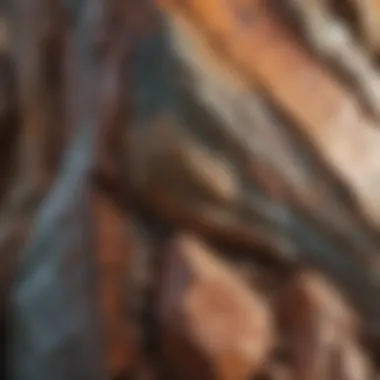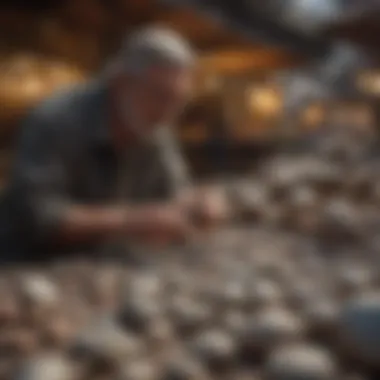Collector Rocks for Sale: A Comprehensive Market Guide


Intro
The ever-evolving collector rock market affords enthusiasts a fascinating view into geology, beauty, and collection practices. Buyers and sellers navigate intricate paths lined with valuable discoveries and hidden treasures. This article serves as a guide through this enriching landscape.
In understanding this field, grasping rock and fossil identification, effective collecting techniques, preservation, and geological insights is essential. Whether detailed orientated novice or seasoned collector, awareness of market currents is invaluable.
Rock and Fossil Identification
Understanding how to identify unique specimens forms the foundation of any serious collection. The world of collecting encompasses various types of rocks and fossils, each holding particular value within the geological community.
Types of Rocks and Fossils
Collectors may encounter several diverse categories, such as:
- Igneous: Formed from cooled magma or lava.
- Sedimentary: Created from particle accumulation, often indicating ancient environments.
- Metamorphic: Resulting from existing rocks under pressure and temperature changes.
Fossils can also present distinct classifications:
- Body Fossils: Preserved remains of organisms, like bones and shells.
- Trace Fossils: Evidence of activity such as footprints or burrow marks.
Characteristics to Look For
When evaluating potential acquisitions, focus on certain attributes that convey value:
- Texture: Notice the grainy feel of igneous rocks or the layering in sedimentary rocks.
- Color: Vivid hues may suggest specific mineral compositions.
- Uniqueness: Uncommon formations tend to captivate collectors
Tools for Identification
The right equipment can significantly enhance identification accuracy. Useful tools include:
- Hand lens for detailed observation.
- Rock hammer for breaking open layers.
- Geologic field guide for reference
Education through structure will prepare a collector to decode valuable stones in marketplaces and shows.
Collecting Tips and Techniques
To become proficient in collecting, adopting effective strategy is crucial. Many tip resonate across beginner and refined strategies alike.
Best Practices for Collecting
Collecting should maintain ethical standards. Always consult local laws pertaining to retrieval. Favor sustainable practices, ensuring minimal environmental disturbance.
Locating Prime Collecting Sites
Some sites are renowned for choices: Montana’s fossils, Arizona’s agate, or Maine’s tourmaline mines present amazing opportunities for enthusiasts. Research local geological formations for ideal digging spots.
How to Safely Extract Specimens
When extracting specimens, consider:
- Use a heavy-duty rock hammer.
- Approach walls and outcrops cautiously.
- Dress for rugged terrain, ensuring the best safety practices.
Following these methods establishes a respected collection with integrity and sustainability.
Preservation and Display
Care for collected items merits as much attention as the collecting itself. Proper preservation and creative displaying maintain the artifacts' beauty and vitality.
Techniques for Preserving Rocks and Fossils
A few tactics aid in maintaining specimens:
- Coating soft fossils in paraffin wax.
- Using silica gel packs for mineral stability.
Proper Storage Methods
Utilizing appropriate storage solutions is vital:
- Keep specimens in clear acrylic boxes or padded pouches.
- Store items away from direct sunlight to prevent fading.
Creative Display Ideas
展uitable methods imaginatively present collections:
- Shadow boxes allow layered viewing.
- Wall mounts or stands display larger pieces beautifully.


资讯 ensures that the vibrancy of one’s treasures captivates any aspirations.
Geological Insights
Thus, the collector encourages a growing understanding of geological significance.
Geological Formations and Processes
Rock and fossils originate from dynamic outward processes, necessitating an intricate appreciation of their witnesses on Earth’s history.
Historical Significance of Rocks and Fossils
Examination of unique items brings together history; some fossils have significantly enhanced knowledge about previous life processes.
Notable Discoveries in the Field
Throughout the open field of geology, coined discoveries arise. Not every collector gets to hold a Tyrannosaurus Rex’s femur or rare labradorite. However, every exciting find carries intrinsic experiential knowledge.
In geology, each rock tells a significant story, connecting past environments to present passions.
Prelims to Collector Rocks
Collector rocks fascinate many enthusiasts around the world. They offer not just aesthetics, but insights into Earth's history and geological processes. Engaging with collector rocks allows individuals to appreciate the depth and diversity of nature’s creations.
Definition and Importance
Collector rocks refer to a variety of geological specimens that attract attention due to their rarity, beauty, or unique characteristics. These rocks are valued by collectors for several reasons. For some, it is the sheer interest in geological structures, while for others, it is about acquiring items that hold historical significance or sensational beauty. Understanding the characteristics defines a successful collector. Without this, one can easily make misinformed purchases, leading to unfavorable outcomes.
Collectors also contribute to research and education by building collections that can eventually be shared with others. An informed community of collectors is crucial for promoting best practices and sustainability in rock collection. Trade and sales are not only about buying but also about understanding the narratives encapsulated in each rock.
Historical Significance
The pursuit of collector rocks is far from a recent trend. It has roots in ancient cultures that cherished natural deposits, many believing in their mystical properties. As civilization advanced, so did the study of geology, and collecting transitioned from curious amateurs to dedicated scholars. Today, prominent museums and institutions rely on donations from collectors to enhance lif in their collections.
Notably, the historical aspect adds layers to the collectible nature. Specific rocks can tell stories of geographical transformations, climate changes, and even human history. This knowledge makes sourcing rare specimens not merely a buying experience but a partnership with Earth's timeline. Having an understanding of this context can significantly enhance the collecting process.
The journey of rock collecting is not just about possession but understanding—each collection tells a story of time.
With organized shows, forums, and institutions highlighting this relationship, the collector community continues to blossom. Public interest has grown, amplifying the importance of preserving this ancient tradition while embracing modern thoughts on sustainable practices. Understanding these dimensions is pivotal for anyone looking to delve into the intricate world of collector rocks.
Types of Collector Rocks
Collector rocks serve as tangible connections to geological processes and Earth's history. Understanding the different types of collector rocks is vital for both beginners and seasoned enthusiasts. This knowledge develops appreciation for unique specimens and guides people in making informed purchases. It also influences value assessments and helps identify what types truly matter for individual collections.
Igneous Rocks
Igneous rocks form from the solidification of molten material, characterized by unique textures and varied mineral content. They primarily come in two types: intrusive and extrusive.
Intrusive igneous rocks cool slowly beneath the Earth's surface, resulting in large crystals. Examples are granite and diorite. On the other hand, extrusive igneous rocks cool rapidly at the surface, leading to smaller crystals, as seen in basalt and pumice.
Collectors often seek out rare formations or striking colors in these rocks. The diversity in appearance means there is substantial market potential and enjoyment for collectors.
Sedimentary Rocks
Sedimentary rocks have gradual formation from layers of sediment piled over time, often holding fossils and providing insights into ancient environments. They comprise three main types: clastic, chemical, and organic.
Clastic sedimentary rocks, like sandstone and shale, form from fragmented pieces of other rocks. Chemical sedimentary rocks arise from chemical precipitation, with limestone as a prime example. Organic sedimentary rocks, such as coal, originate from biological material.
Many collectors appreciate these rocks for their historical significance, which they reveal about Earth’s past. Possessing well-preserved fossils can elevate the value of these specimens, making this type a staple in many collections.
Metamorphic Rocks
Metamorphic rocks develop under heat and pressure, transforming pre-existing rocks into new forms. This transformation process alters mineral composition and can create unique textures and patterns. Common types include schist, gneiss, and marble.
Collecting traits depend on visual style and geological history. For example, collectors might favor distinctive foliation or impressive interlocking mineral patterns. Each sample can act as a piece of nature’s artwork, making them highly sought after by enthusiasts.
Rare and Unique Specimens
Within any collection, the allure of rare and unique specimens is inarguable. These are rocks that provide not only aesthetic appeal but also considerable geological intrigue. Categories can include rare minerals, highly localized geological formations, or fossils of particularly notable significance.
- Distinct characteristics make every piece a story waiting to be told.
- Such specimens often include research-grade specimens, historical context, or pieces with known provenance.
The value of these samples hinges on rarity and desirability. Collectors often pay premium prices for specimens with unique features or fascinating histories.
Collectors always consider provenance and expert analysis, elevating the trustworthiness and result of the hobby.


The range represented in the types of collector rocks signifies much more than distinct forms; it signifies opportunities for investment and personal growth within the collecting endeavor.
Factors Influencing Rock Prices
Understanding the dynamics of pricing in the collector rock market is critical. The price of rocks can vary significantly based on various characteristics which collectors should consider. Knowledge of these factors not only aids collectors in making informed purchases but also helps them gauge the value of their existing collections. Recognizing how rarity merges with demand, evaluating the conditions and quality, and staying attuned to market trends will lead to successful collecting.
Rarity and Demand
Rarity sits at the core of rock pricing. The less available a specimen, the higher its perceived value. When a rock is in high demand yet scarce, prices increase markedly. Some minerals are rare due to ecological or geographical limitations; for instance, painite, historically considered one of the rarest minerals, can command prices that can baffle onlookers.
Collectors often focus on acquiring these rare specimens, propelling their prices upward. Similarly, significant geological formations that attract attention can also see pronounced price inflation due to collector enthusiasm. Demand often dictates trends, transforming regular stones into highly sought-after collectibles.
Furthermore, following forums or marketplaces where collectors discuss trends can provide insights into what is fetching high prices and what new interests are emerging.
Where to Buy Collector Rocks
Knowing where to buy collector rocks is essential for anyone moving within this niche yet exciting domain. Having access to various places increases one's options and opens up opportunities to discover sublimes specimens. Each buying venue has unique characteristics whether focusing on pricing, variety, or accessibility. Choosing the right place to buy can affect both the experience and the quality of the specimens opurchased.
Online Marketplaces
Online marketplaces have emerged as a significant component in the buying process of collector rocks. They offer a vast range of products from various sellers, making it possible to find unique and rare pieces. Websites like eBay, Etsy, and specialized geology sites hold extensive lists, which increases exposure for both collectors and sellers.
Here's a superficial look at some commonly visited platforms:
- eBay: A wide selections of rocks, has auctions as well as set-price listings.
- Etsy: Focuses on handmade and vintage rocks-contemporary items.
- Specialized Geology Websites: Places dedicated specifically to rock collectors often present many pieces of higher quality.
However, with online purchases, portability is a factor worth considering. Monitoring quality from images can be deceptive. Thus, checking ratings and reading feedback vert important before buying. It enables potential buyers to draw connections between honest selling behaviours and previous customers.
Rock Shows and Trade Fairs
Rock shows and trade fairs serve as immersive experiences for collectors. These events typically gather a wide of context calibre vendors and amateurs. They are an opportunity for face-to-face connections that online shopping cannot replicate. Here are few reasons these events draw attention:
- Community Engagement: Attendees share collective knowledge and experience. It's a chance to learn from seasoned collectors as well as to exchange informations.
- Touch and Feel: Seeing a rock in person allows collectors to assess physical traits that photographs might misrepresent.
- Competition: In such venues, one may discover competitive pricing directly from saritas.
Participating in these shows can build a collector's networks, allowing them to make connections for future trades. Paying attention to local state lists ensures awareness of upcoming events.
Local Dealers and Shops
Purchasing from local dealers and shops involves different dynamics. Locally operated places often emphasise understanding and expertise peculiar to specific regional hobbies and demands. This facilitates a personalized experience by allowing face-to-face discussions between both parties.
Some avenues to look out include:
- Gem and Mineral Shops: These often cater not just for rocks but provide vast options for related hobbies like lapidary or jewelry-making. It might lead startled customers finding different interests.
- Antique Stores: Surprisingly, antique shops may integrate creativity with collections of old minerals and artifacts. They could have items with historical context worth exploring.
- Museums and Natural History Centers: They can have gift shops where collector rocks both relevant and education can be acquired. These may lean towards quality uniqueness rather than quantity.
Additionally, crafting a consumer-relationship towards local instructors or trade experts activities also cultivates remaining rooted in collector habits. Working in tandem with local shops and mentors augments knowledge while building trust within the carbon nerwork in the locality.
In essence, the relationship spans far beyond just a purchase. Understanding where to buy enhances the overall experience of rock collecting, affording collectors knowledge directly tied to the art.
Evaluating Rock Quality
Understanding how to evaluate rock quality is essential in the collector rocky market. As someone preparing to invest in collector rocks, knowing about the qualities that make them valuable can significantly influence purchasing decisions. Just like artworks, collector rocks come in various grades and attributes that enhance or diminish their value.
Physical Characteristics
The physical characteristics of a rock provide vital clues to its identity and value. Factors to consider include:
- Color: The hue of a rock can indicate its mineral content and origin.
- Texture: Grain size, surface smoothness, and minerals' distribution can affect both aesthetics and classification.
- Shape: Geological processes influence the form, like angular vs. rounded edges. Some shapes are more desirable based on unique occurrences.
- Weight: The density can hint at the rock type and width associated with that of typical specimens.
It's important to note that abnormalities or rare features can greatly enhance a rock’s appeal. Collectors should assess these aspects with a critical eye.
Chemical Composition
Chemical analysis can be as telling as gait or posture when observing living beings. A rock's elemental makeup defines its type and characteristics more rigorously.
- Mineral Identification: Rocks made from specific mineral combinations are often identified through a geological test kit. Having a basic understanding of mineral formulas can assist amateur collectors.
- Purity Level: Some rocks may differ in purity, influencing value. Evidence of impurities may indicate regional geological occurrences.
- Weathering Effects: Chemicals naturally affect the breakdown and reactions that minerals undergo. As collectibles age, it's paramount to be conscious of these circumstances.
Collectors should frequently consider whether chemical attributes enhance or detract from a rock’s fulfillment in any collection.
Geological Context
The geological context of rocks provides not just foundational knowledge but also significance. Here are primary components:
- Origin: Knowing where, and how, a rock was formed increases appreciation. Elucidation around a specific formation or source location might fetch higher interest.
- Era: Certain eras are often deemed more
Collecting Ethics and Guidelines
Collecting rocks and geological specimens is not just a hobby; it embodies a connection to nature, science, and history. Engagement in this field comes with profound responsibilities that every collector must recognize. The significance of adhering to collecting ethics and guidelines cannot be overstated. It fosters a community of respect, encourages sustainable practices, and protects the natural environment while allowing the joy of collecting to flourish.


Sustainable Collecting Practices
Sustainable collecting practices focus on minimizing the impact one has on natural ecosystems while pursuing the hobby. This involves gathering specimens in a responsible manner that does not disrupt the geological features. Some best practices include:
- Researching Locations: Before collecting, it is essential to understand the rules and regulations of the area. Some locations may be protected, and collecting may be prohibited.
- Leave No Trace: Practitioners should only take what they need and leave the site as they found it. This not only preserves the area for future collectors but also helps maintain ecological balance.
- Avoid Over-Collecting: Limit your collection to a few specimens rather than removing large quantities. This helps prevent depleting the resource in a given area.
- Eco-Friendly Techniques: Use gentle tools for extraction. Avoid disruptive methods that can damage the surrounding environment.
Practicing sustainability helps collectors gain respect within the rock collecting community and distinguish themselves as conscientious stewards of nature.
Legal Considerations
Legal considerations in rock collecting encompass local, national, and international laws. Being aware of these regulations is crucial for ethical collecting. Ignoring legal considerations can lead not only to personal repercussions but can also harm the integrity of the collection at large. Important points to consider include:
- Permits: Certain areas may require special permits for collecting. Always verify this before proceeding to avoid fines or legal action.
- Property Rights: Ensure you have permission to collect on private land and respect boundaries. Trespassing can have serious legal consequences.
- Protection of Fossils: Some fossils are protected by law. Collecting these without proper permission can lead to hefty penalties and loss of valuable pieces.
- CITES Regulations: Be informed about the Convention on International Trade in Endangered Species of Wild Flora and Fauna. Certain rock and mineral types can fall into this category, impacting export and sale rules.
Educating oneself about the legal landscape sets the framework for a responsible collector who cares for the community and environment.
Storage and Preservation Techniques
Storage and preservation techniques are vital for maintaining the integrity and appeal of collector rocks. Collectors benefit significantly from effectively managing how their specimens are kept and cared for. Rocks, being natural formations, can differ drastically in hardness, structure, and composition. Improper handling can lead to alterations that detract from their value and aesthetics. By implementing suitable storage methods and preserving them carefully, collectors ensure that their investments remain intact.
Proper Storage Conditions
Maintaining proper storage conditions entails controlling various environmental factors. Temperature and humidity play crucial roles in stone preservation. Keep collector rocks in a controlled environment to prevent moisture accumulation, which can lead to mold or crystal damage. An ideal room temperature around 20°C or 68°F and a relative humidity between 30% and 50% is recommended.
Collectors should store rock specimens in cabinets or shelves designed for them. Use padded shelves or boxes to cushion the rocks and prevent scratches. Ensure that rocks are not piled on top of one another to avoid contact damage. It's also advisable to utilize containers made from inert materials, such as acid-free paper boxes, to assure safety against chemical reactions.
Avoid exposure to direct sunlight, as UV light can alter colors or even cause a breakdown of some minerals. In summary, proper storage conditions help maintain both the physical appearance and the geological significance of collector rocks.
Cleaning and Maintenance
Routine cleaning and maintenance are also important aspects of rock collection care. Dust and residue can accumulate on specimens over time, diminishing their visual appeal and potentially causing long-term damage. However, cleaning methods should be tailored to the type of rock. For most specimens, a soft brush is sufficient to remove loose dirt. In cases of stubborn stains, a damp cloth can be utilized with mindful application, ensuring not to soak the material.
Avoid using chemicals that can cause reactions with specific minerals. Stick to basic cleaning solutions, such as mild soap and water, if necessary. Pay attention to geological contexts, as some rocks may require special attention or specific cleaning procedures.
Adjust maintenance procedures based on rock type and environment to keep the collection in prime condition. Remember that even storaging and cleaning come under collecting ethics, which relates to respecting and understanding your collection's significance.
In preserving geological specimens, collectors support both scientific study and the appreciation of Earth’s history.
Overall, diligent attention to storage and preservation techniques is fundamental for serious rock collectors who wish to enjoy their hobbies fully and safeguard their investments.
The Role of Community in Collecting
Community plays a pivotal role in the world of collecting rocks. Engaging with others fosters a deeper understanding of geology, trends, and collecting best practices. It creates an environment for knowledge exchange and enhances both skills and enthusiasm. Understanding value, rarity, and ethical practices becomes easier through community engagement. The pursuit of collector rocks isn't just about individual accumulation; it's informed by connection and shared passion.
Forums and Groups
Forums and groups dedicate space for collectors to discuss topicn hegs inclusive of techniques, localized finds, and resources. Websites like Reddit have multiple communites dedicated ot specific interests in geology and collectors can ask questions, seek advice, and share wtih others.
- Benefits of forums and groups include:
- Exchange of knowledge on rare rocks.
- Updates on market trends through news spread within these communities.
- Direct connections to sellers and events.
- Reviews on authenticity of various specimens, promoting informed purchasing.
Joinng such forums often leads to friendships and partnerships in collecting. One can learn patiently and through observation.
Collaborative Events
Collaborative events such as rock shows and field trips are invaluable opportunities for collectors. These gatherings create space to meet like-minded individuals and exchange resources and experiences. For example, joining a local rock club can lead to excursions to quarries or natural sites where collectors can find specimens together.
- Key aspects of collaborative events:
- Foster personal connections with others passionate about geology.
- Attend workshops that teach preservation techniques or identify unknown specimens.
- Provide platforms for showcasing personal collections, securing constructive feedback.
- Network and find potential trading opportunities with fellow collectors.
Engaging actively in the community truly amplifies the collecting experience and understanding of rock specimens on multiple levels.
Finale
The conclusion section holds significant importance within this article as it encapsulates essential insights and reflections on the collector rock market.
Reflection on the Collector Market
The collector rock market has seen notable evolution over recent years. Awareness about geological specimens is growing. Collectors are now more informed and value not just the aesthetics but also the scientific context of their pieces. This development impacts how specimens are bought and sold. More than ever, collectors gain satisfaction from understanding provenance and rarity. Buyers are increasingly seeking to connect the story behind each piece with their personal interests. They are looking for more than mere rocks; they want pieces that contribute to their enthusiasm for the natural world.
Additionally, the online platforms have made a tremendous impact. They enable a broader audience to access diverse collector rocks, but they also introduce challenges, such as ensuring quality and authenticity. Keeping this transparency fosters trust among community members.
Future Trends in Collecting
Looking ahead, several trends emerge within the collector rocks community. One significant shift is the rise of sustainability practices. Collectors and sellers are concentrating on eco-friendly sourcing methods. This results in increased demand for ethically obtained rocks.
Furthermore, technology advances also play a crucial role. For instance, augmented reality apps may allow potential buyers to interact more deeply with specimens online. Such tools can help assess quality and relevance more effectively.
Another trend is the focus on educational content. Both new collectors and seasoned ones are seeking detailed information about the geological significance of their collections. Workshops focusing on collecting ethics and rock identification skills are likely to become standard. Community engagement will also be vital. Events fostering interaction, like meet-ups and collaborative exhibitions, create a bond among collectors and increase sharing of knowledge.
The future of rock collecting seems promising as it reflects a growing sense of responsibility. Enthusiasts will foster interconnectedness and appreciation for our planet’s geological treasures.







